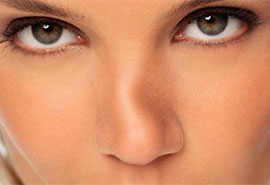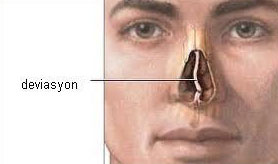
What is nasal septum deviation ?
Nasal septal deviation means the inclination of the cartilage-bone wall which is normally in the midline in the nose.
What kind of complaints does deviated septum cause ?
The most important complaint caused by deviated septum is nasal obstruction. In such a case, the patient may feel that he or she cannot breath properly through his nose, especially when he or she exercises, and he or she can wake up with a dry mouth. Deviated septum may contribute to snoring, can cause continuous mouth breathing and pharyngitis, and may predispose to sinusitis and nosebleeds.
At what age can nasal septum deviation surgery be performed ?
The lower age limit, which is considered classically for nasal septum deviation surgery, is 18. It has been reported in the literature that surgery can be performed at younger ages in particular cases.
What is turbinate ?
Turbinates are the organs located on both side walls of the nose. There are 3 pairs of turbinates in the nose, namely the lower, middle and upper turbinates.
What can an enlarged turbinate lead to ?
If the turbinates are enlarged, it can lead to nasal obstruction. Especially in patients with nasal septum deviation, the turbinate on the opposite side of the deviation is exposed to more air and swells permanently over time, so the nose can be completely blocked. In addition, the middle turbinate can be inflated with air like a balloon (concha bullosa), which may cause sinusitis by blocking the opening of the sinuses, or it may push the septum and cause nasal septum deviation.
Is the nasal septum deviation surgery performed with general anesthesia ?
Although nasal septum deviation surgeries can be performed with local anesthesia or sedation, today, general anesthesia is preferred for patient’s and surgeaon’s comfort.
Can turbinate surgeries be performed in the same session with nasal septum deviation surgery ?
Yes, both surgeries can be performed in the same session.
Can turbinate surgery and nasal septum deviation surgeries be performed in the same session with rhinoplasty ?
Yes, all three surgeries can be performed in the same session.
What should be considered before the operation ?
The use of some medications as aspirin should be discontinued 1 week before surgery. At the time of the operation, the patient should not have an infection, especially an upper respiratory tract infection.
Which methods are available for turbinate reduction ?
There are many methods for reducing the size of the nasal turbinates. Among these, the most commonly used are radiofrequency, electrocauterization and removing a part of the concha. Recently, the most widely used method has become the radiofrequency. The basis of this method is the reduction of the nasal turbinate by shrinking it using radiofrequency energy without any incision.

How is ‘concha bullosa’ surgery performed ?
In concha bullosa surgery, the half of the middle nasal turbinate, which is inflated like a balloon, is cut and removed using endoscopes generally.
How is the septum deviation surgery performed ?
The basic principle in deviation surgeries is to correct the cartilage-bone convexities of the septum while maintaining the support the nose. In most of the cases, it is possible to perform the operation by making an incision inside the nose, which we call the closed technique. In some cases where there is also an external deviation, an open technique can be performed.
Is nasal packing used after surgery ?
For years, nasal packing has been the scariest part of nose surgery. Because, former classical nasal packings were blocking the nose completely, and their removal was painful. For years, I have been using Silicone Doyle Splints, which allow the patient to breathe through the air channels immediately after the surgery, unless they are blocked by a blood clot, and as they do not stick to the nose they do not cause pain or bleeding when they are removed.
Do I need to stay in the hospital after the surgery ?
The patient who has nasal septum deviation surgery can be discharged on the same day under normal conditions.
What should be considered after the operation ?
After the surgery, the air channels in the silicone splints inside the nose are tried to be kept open by rinsing them with special saline solutions or sprays. These silicones are removed two or three days after the operation (it may be a little longer if necessary). Afterwards, nasal rinsing is continued, and moisturizing sprays can be used to reduce the crusts that may occur in the nose. Nasal cleaning is done by seeing the patient once a week for 3-4 weeks. Another important point is that if there is a concomitant condition such as hay fever that may contribute to nasal obstruction, its treatment should not be neglected.
What complications can occur after surgery ?
Nasal septum deviation and turbinate surgeries have a very low complication rate. Possible complications include bleeding, septal haematoma (blood accumulation), infection, adhesions in the nose (synechia), and formation of a hole in the midline wall of the nose (septal perforation). Septal perforation is seen around 1-2% in an operation performed with a modern technique. It usually does not cause any complaints. In some patients, it may cause nasal crusting, bleeding, nasal obstruction and a whistling sound while sleeping. Although it can be fixed with a second surgery if necessary, the rate of patients who will need it is very low. It is possible to avoid all these complications to a great extent with meticulous surgery and appropriate post-operative care.


